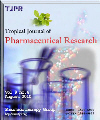
|
Tropical Journal of Pharmaceutical Research
Pharmacotherapy Group, Faculty of Pharmacy, University of Benin, Benin City, Nigeria
ISSN: 1596-5996
EISSN: 1596-5996
Vol. 14, No. 8, 2015, pp. 1341-1348
|
 Bioline Code: pr15176
Bioline Code: pr15176
Full paper language: English
Document type: Research Article
Document available free of charge
|
|
|
Tropical Journal of Pharmaceutical Research, Vol. 14, No. 8, 2015, pp. 1341-1348
| en |
Penetration Enhancement Effect of Turpentine Oil on Transdermal Film of Ketorolac
Wang, Fu-Liang; Ji, Hong-Mei; Zhu, Jian-You; Xu, Gui-Jun; Guan, Yu-Zhong & Chen, Ye-Jun
Abstract
Purpose:
To prepare transdermal films of ketorolac tromethamine (KT) and study the effect of
turpentine oil as a penetration enhancer for the drug.
Methods:
Transdermal films of KT were prepared with Carbopol-934 and ethyl cellulose, with turpentine
oil as the penetration enhancer, using solvent evaporation method. The films were characterized for
physicochemical properties, ex vivo permeation, as well as in vivo anti-inflammatory and analgesic
activities in Wistar rats.
Results:
The transdermal films were uniform in weight and thickness, flat, with high drug content (93.9
to 98.5 %) and of high folding endurance (134.0 to 180.0). Drug permeation through excised rat
abdominal skin was prolonged, with the total drug release ranging from 58.88 to 88.98 % in 24 h. The
films containing penetration enhancer showed higher drug permeation than the one without the
enhancer; furthermore, drug permeation increased with increase in the concentration of the enhancer.
The films were non-irritant to the skin. The transdermal films prepared with permeation enhancers
showed greater anti-inflammatory activity (87.55 ± 2.50 and 83.24 ± 2.29 % inhibition of rat paw edema
at the end of 12 h for formulations F2 and F3, respectively, compared to that of the formulation without
enhancer with 69.99 %) as well as greater analgesic activity (quicker onset of analgesia in 1.5 h with
longer duration of 10 to 12 h).
Conclusion:
Transdermal films of ketorolac have a potential for use in the treatment of pain and
inflammation. Incorporation of turpentine oil in the films enhances not only drug flux but also analgesic
and anti-inflammatory activities in rats.
Keywords
Transdermal patch; Spinal cord injury; Ketorolac; Analgesic; Anti-inflammatory; Penetration enhancer; Turpentine oil
|
| |
© Copyright 2015 - Tropical Journal of Pharmaceutical Research
Alternative site location: http://www.tjpr.org
|
|
